Impact of Intersection Left Turn Guide Lines Configuration on Novice Drivers’ Behavior
Abstract
1. Introduction
2. Material and Methods
2.1. Intersection Survey
2.2. Driving Simulator Experiment Design
2.2.1. Experimental Equipment
2.2.2. Experimental Participants
2.2.3. Experimental Scenario Design
2.2.4. Experimental Procedure
2.3. Data Extraction
2.4. Data Analysis Methods
3. Results
3.1. Impact Analysis Based on Trajectory Characteristics
3.1.1. Small Intersection
3.1.2. Medium Intersection
3.1.3. Large Intersection
3.1.4. Wilcoxon Rank-Sum Test for Trajectories
3.2. Impact Analysis Based on Steering Angle and Speed Difference
3.2.1. Small Intersections
3.2.2. Medium Intersections
3.2.3. Large Intersections
3.3. Impact Analysis Based on Eye-Tracker Data
4. Discussion
4.1. Discussion of Vehicle Trajectory Characteristic Results
4.2. Discussion of Steering Angle Characteristic Results
4.3. Discussion of Speeding Characteristic Results
4.4. Discussion of Driver Gaze Characteristic Results
5. Conclusions
Author Contributions
Funding
Institutional Review Board Statement
Informed Consent Statement
Data Availability Statement
Conflicts of Interest
References
- National Highway Traffic Safety Administration. 2015 motor vehicle crashes: Overview. Traffic Saf. Facts: Res. Note 2016, 2016, 1–9. [Google Scholar]
- McCartt, A.T.; Mayhew, D.R.; Braitman, K.A.; Ferguson, S.A.; Simpson, H.M. Effects of age and experience on young driver crashes: Review of recent literature. Traffic Inj. Prev. 2009, 10, 209–219. [Google Scholar] [CrossRef] [PubMed]
- Lord, D. Analysis of pedestrian conflicts with left-turning traffic. Transp. Res. Rec. 1996, 1538, 61–67. [Google Scholar] [CrossRef]
- Zhang, X.; Liu, P.; Chen, Y.; Bai, L.; Wang, W. Modeling the frequency of opposing left-turn conflicts at signalized intersections using generalized linear regression models. Traffic Inj. Prev. 2014, 15, 645–651. [Google Scholar] [CrossRef]
- Stephens, A.N.; Beanland, V.; Candappa, N.; Mitsopoulos-Rubens, E.; Corben, B.; Lenné, M.G. A driving simulator evaluation of potential speed reductions using two innovative designs for signalised urban intersections. Accid. Anal. Prev. 2017, 98, 25–36. [Google Scholar] [CrossRef]
- Appiah, J.; King, F.A.; Fontaine, M.D.; Cottrell, B.H. Left turn crash risk analysis: Development of a microsimulation modeling approach. Accid. Anal. Prev. 2020, 144, 105591. [Google Scholar] [CrossRef]
- Yang, M.; Yu, H.; Bai, L. Simulation-based evaluation of variation in left-turn paths in the coordinated intersection management. J. Adv. Transp. 2021, 2021, 6243530. [Google Scholar] [CrossRef]
- Wang, X.; Abdel-Aty, M. Modeling left-turn crash occurrence at signalized intersections by conflicting patterns. Accid. Anal. Prev. 2008, 40, 76–88. [Google Scholar] [CrossRef]
- Oh, J.; Kim, E.; Kim, M.; Choo, S. Development of conflict techniques for left-turn and cross-traffic at protected left-turn signalized intersections. Saf. Sci. 2010, 48, 460–468. [Google Scholar] [CrossRef]
- Abdeljaber, O.; Younis, A.; Alhajyaseen, W. Analysis of the trajectories of left-turning vehicles at signalized intersections. Transp. Res. Procedia 2020, 48, 1288–1295. [Google Scholar] [CrossRef]
- Chai, H.; Zhang, Z.; Hu, H.; Dai, L.; Bian, Z. Trajectory-Based Conflict Investigations Involving Two-Wheelers and Cars at Non-Signalized Intersections with Computer Vision. Expert Syst. Appl. 2023, 230, 120590. [Google Scholar] [CrossRef]
- Qu, S.; Guo, F. Behavioral Patterns of Drivers under Signalized and Unsignalized Urban Intersections. Appl. Sci. 2024, 14, 1802. [Google Scholar] [CrossRef]
- Li, H.; Li, S.; Li, H.; Qin, L.; Li, S.; Zhang, Z. Modeling left-turn driving behavior at signalized intersections with mixed traffic conditions. Math. Probl. Eng. 2016, 2016, 4015271. [Google Scholar] [CrossRef]
- Dias, C.; Iryo-Asano, M.; Oguchi, T. Predicting optimal trajectory of left-turning vehicle at signalized intersection. Transp. Res. Procedia 2017, 21, 240–250. [Google Scholar] [CrossRef]
- Sun, J.; Qi, X.; Xu, Y.; Tian, Y. Vehicle turning behavior modeling at conflicting areas of mixed-flow intersections based on deep learning. IEEE Trans. Intell. Transp. Syst. 2019, 21, 3674–3685. [Google Scholar] [CrossRef]
- Dias, C.; Iryo-Asano, M.; Abdullah, M.; Oguchi, T.; Alhajyaseen, W. Modeling trajectories and trajectory variation of turning vehicles at signalized intersections. IEEE Access 2020, 8, 109821–109834. [Google Scholar] [CrossRef]
- Wang, B.; Liu, Y.; Liang, G.; Men, Y. Behavior-based safety evaluation model of vehicles turning left at intersections with a permitted left-turn phase. J. Transp. Eng. Part A Syst. 2023, 149, 04023091. [Google Scholar] [CrossRef]
- Zhao, J.; Knoop, V.L.; Sun, J.; Ma, Z.; Wang, M. Unprotected Left-Turn Behavior Model Capturing Path Variations at Intersections. IEEE Trans. Intell. Transp. Syst. 2023, 24, 9016–9030. [Google Scholar] [CrossRef]
- Wolfermann, A.; Alhajyaseen, W.K.; Nakamura, H. Modeling speed profiles of turning vehicles at signalized intersections. In Proceedings of the 3rd International Conference on Road Safety and Simulation RSS2011, Transportation Research Board TRB, Indianapolis, IN, USA, 14–16 September 2011; pp. 1–17. [Google Scholar]
- Knodler, M.A., Jr.; Noyce, W.A. Tracking driver eye movements at permissive left-turn. Driv. Assess. Conf. 2005, 3, 2005. [Google Scholar]
- Zhao, D.; Ma, J.; Wang, B.; Liao, Y. The influence of left-turn lanes widening on the usability of guide system at intersection entrance. In Proceedings of the Fifth International Conference on Traffic Engineering and Transportation System (ICTETS 2021), Chongqing, China, 24–26 September 2021; Volume 12058, pp. 809–815. [Google Scholar]
- Ringhand, M.; Siebke, C.; Bäumler, M.; Petzoldt, T. Approaching intersections: Gaze behavior of drivers depending on traffic, intersection type, driving maneuver, and secondary task involvement. Transp. Res. Part F Traffic Psychol. Behav. 2022, 91, 116–135. [Google Scholar] [CrossRef]
- Alhajyaseen, W.K.; Asano, M.; Nakamura, H.; Tan, D.M. Stochastic approach for modeling the effects of intersection geometry on turning vehicle paths. Transp. Res. Part C Emerg. Technol. 2013, 32, 179–192. [Google Scholar] [CrossRef]
- Edara, P.; Breslow, S.; Sun, C.; Claros, B.R. Empirical evaluation of J-turn intersection performance: Analysis of conflict measures and crashes. Transp. Res. Rec. 2015, 2486, 11–18. [Google Scholar] [CrossRef]
- Zhao, J.; Liu, Y. Safety evaluation of intersections with dynamic use of exit-lanes for left-turn using field data. Accid. Anal. Prev. 2017, 102, 31–40. [Google Scholar] [CrossRef] [PubMed]
- Jiang, C.; Qiu, R.; Fu, T.; Fu, L.; Xiong, B.; Lu, Z. Impact of right-turn channelization on pedestrian safety at signalized intersections. Accid. Anal. Prev. 2020, 136, 105399. [Google Scholar] [CrossRef] [PubMed]
- Wei, F.; Guo, W.; Liu, X.; Liang, C.; Feng, T. Left-turning vehicle trajectory modeling and guide line setting at the intersection. Discret. Dyn. Nat. Soc. 2014, 2014, 950219. [Google Scholar] [CrossRef]
- Heinrich, F.; Kaste, J.; Kabil, S.G.; Sanne, M.; Küçükay, F.; Henze, R.; Axmann, J. Methods for modeling the steering wheel torque of a steer-by-wire vehicle. Automot. Engine Technol. 2022, 7, 53–64. [Google Scholar] [CrossRef]
- Wang, W.; Xi, J.; Chen, H. Modeling and recognizing driver behavior based on driving data: A survey. Math. Probl. Eng. 2014, 2014, 245641. [Google Scholar] [CrossRef]
- Bosurgi, G.; Di Perna, M.; Pellegrino, O.; Sollazzo, G.; Ruggeri, A. Drivers’ Steering Behavior in Curve by Means of New Indicators. Infrastructures 2024, 9, 43. [Google Scholar] [CrossRef]
- Bosurgi, G.; Pellegrino, O.; Ruggeri, A.; Sollazzo, G. Synthetic Drivers’ Performance Measures Related to Vehicle Dynamics to Control Road Safety in Curves. Vehicles 2023, 5, 1656–1670. [Google Scholar] [CrossRef]
- Singh, H.; Kathuria, A. Analyzing driver behavior under naturalistic driving conditions: A review. Accid. Anal. Prev. 2021, 150, 105908. [Google Scholar] [CrossRef] [PubMed]
- Wang, Z.F.; Dong, M.M.; Gu, L.; Rath, J.J.; Qin, Y.C.; Bai, B. Influence of road excitation and steering wheel input on vehicle system dynamic responses. Appl. Sci. 2017, 7, 570. [Google Scholar] [CrossRef]
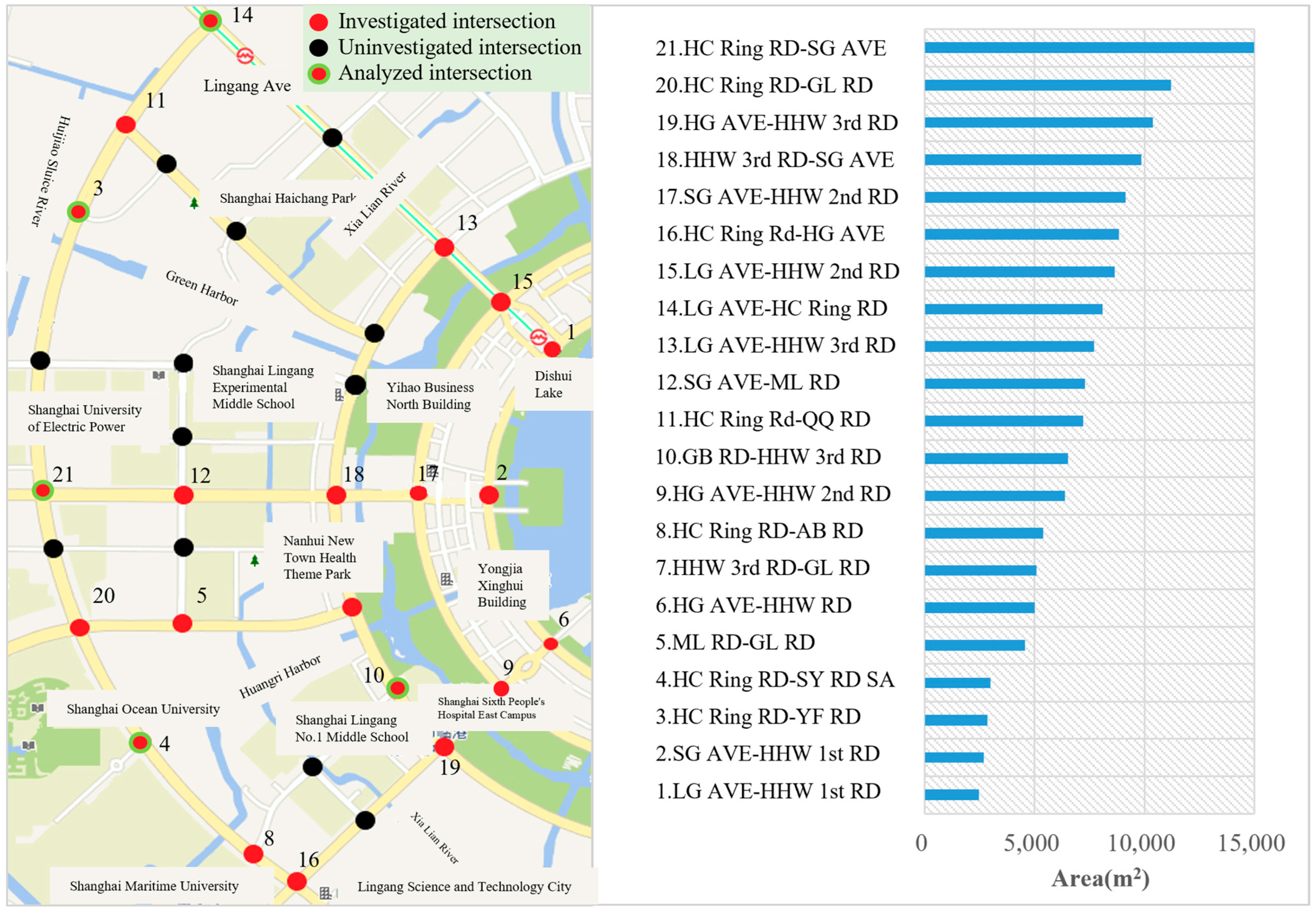
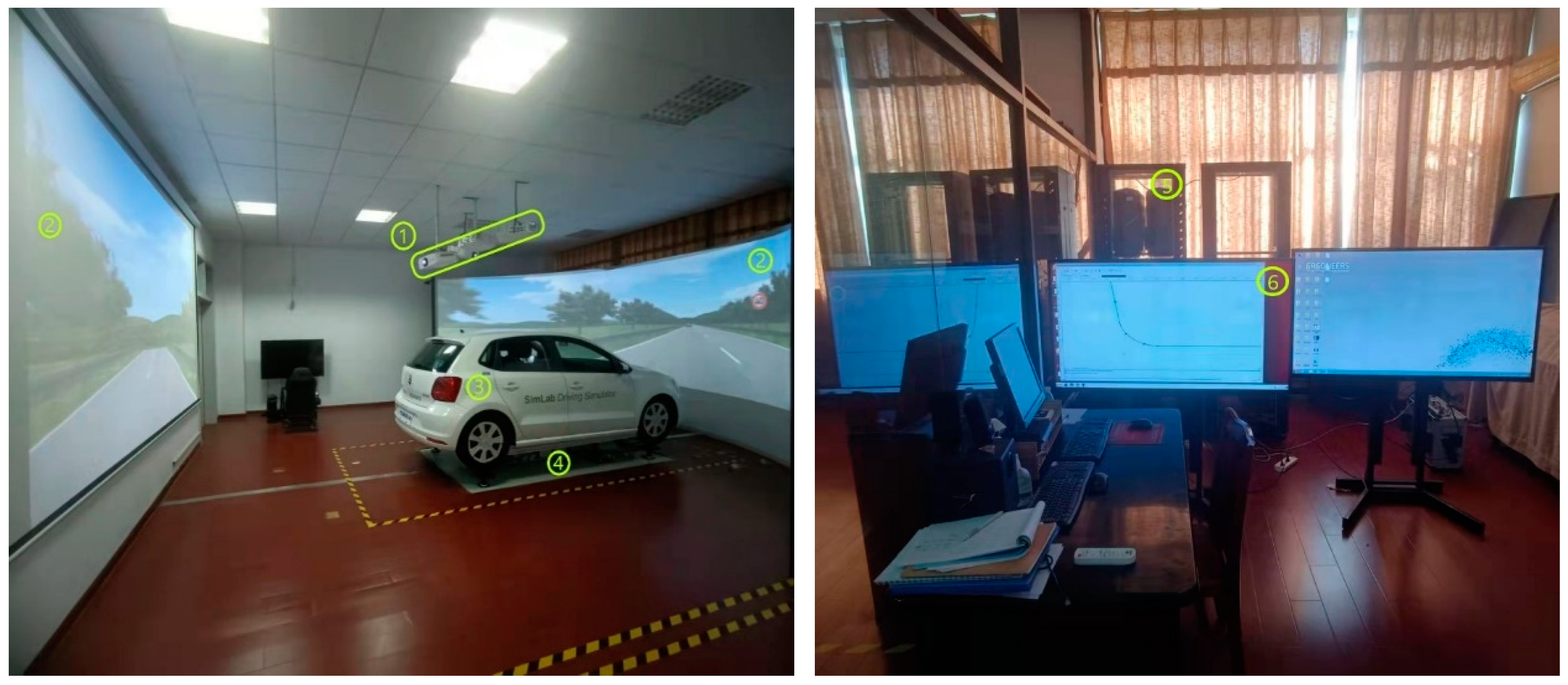

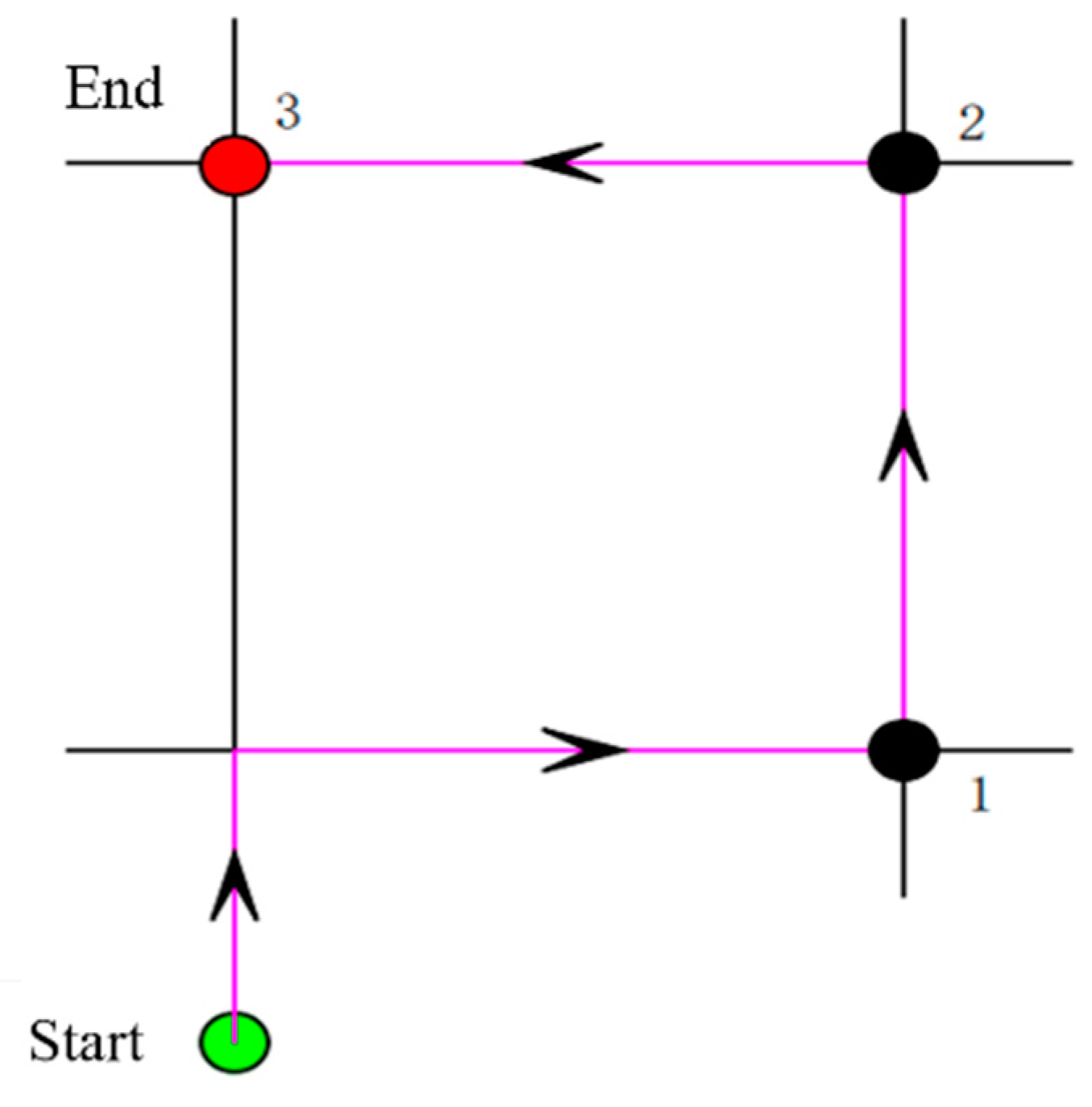
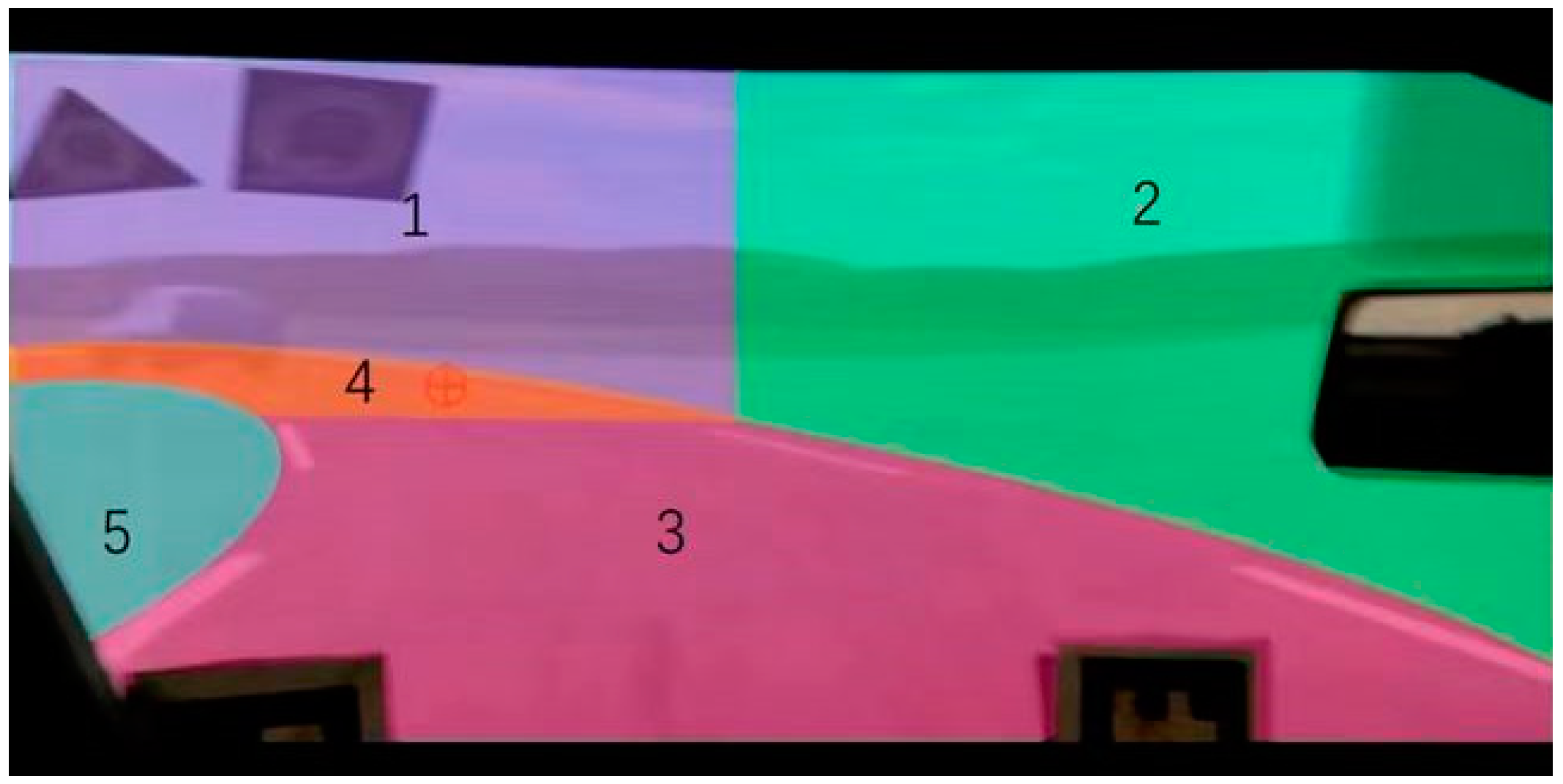
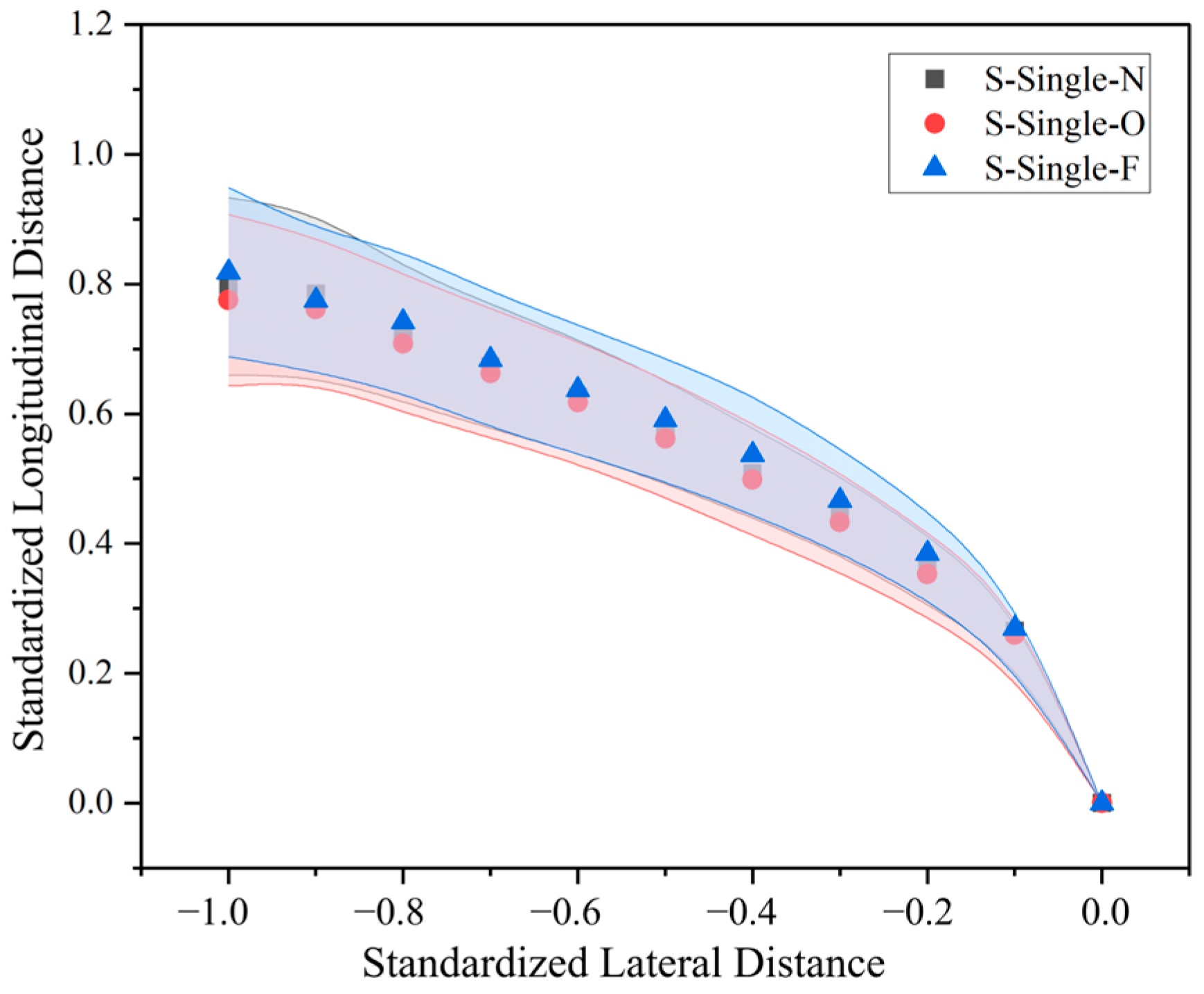
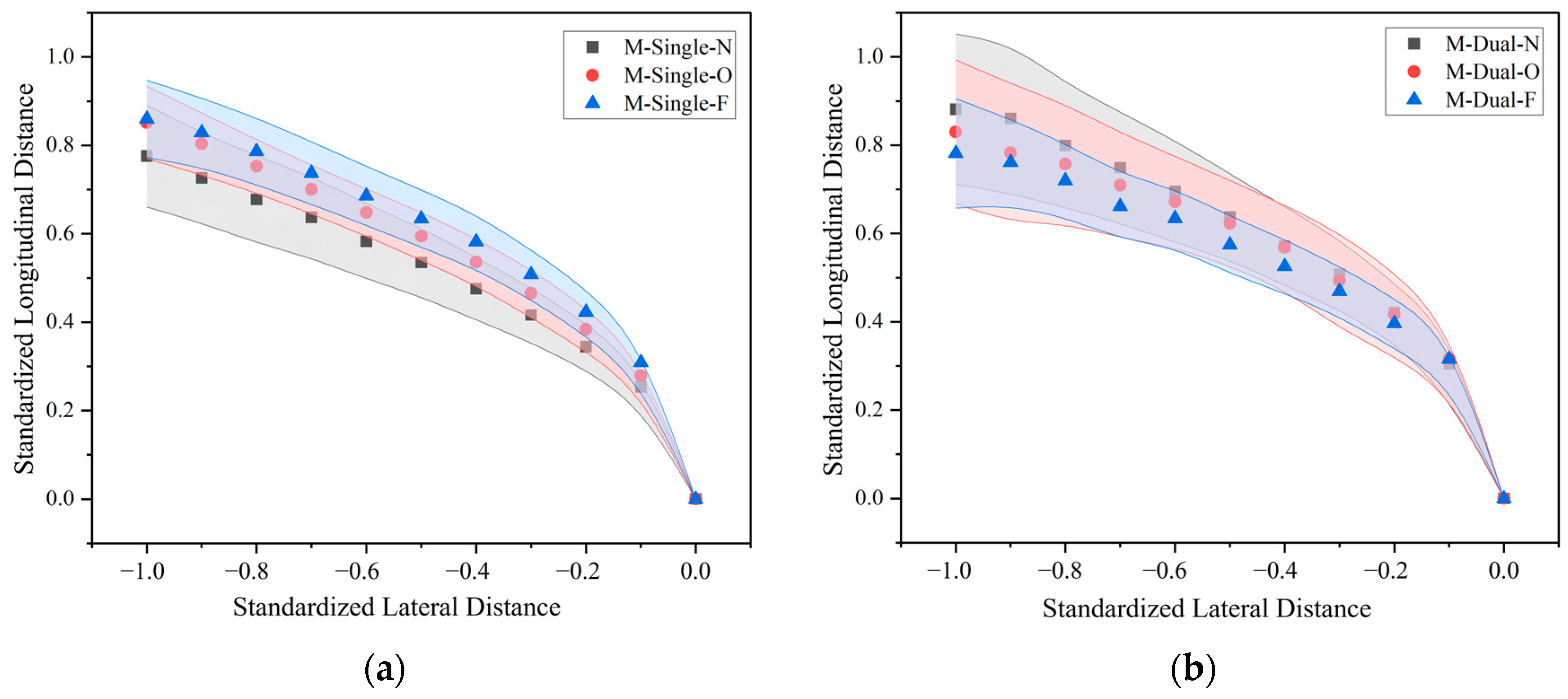

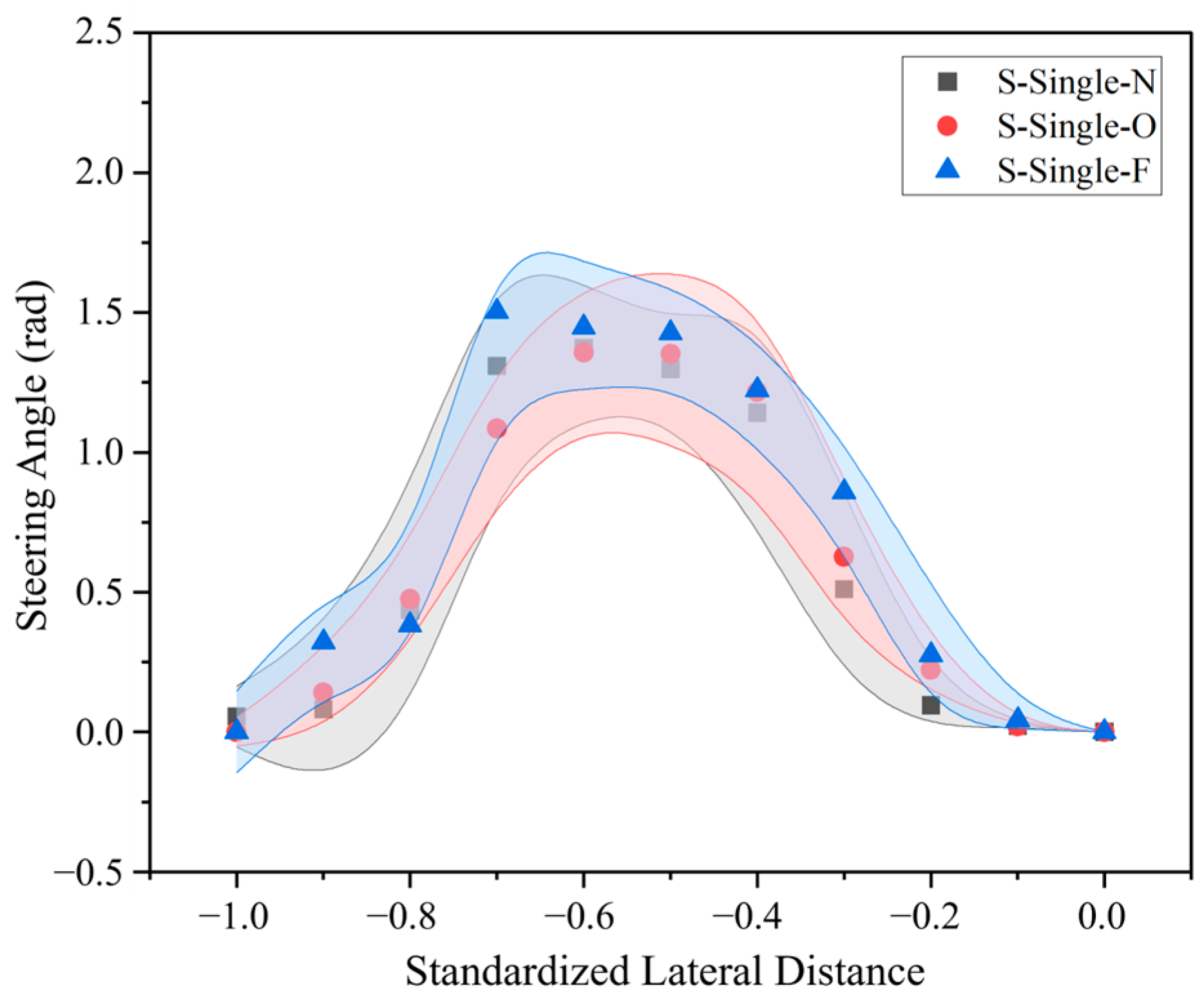

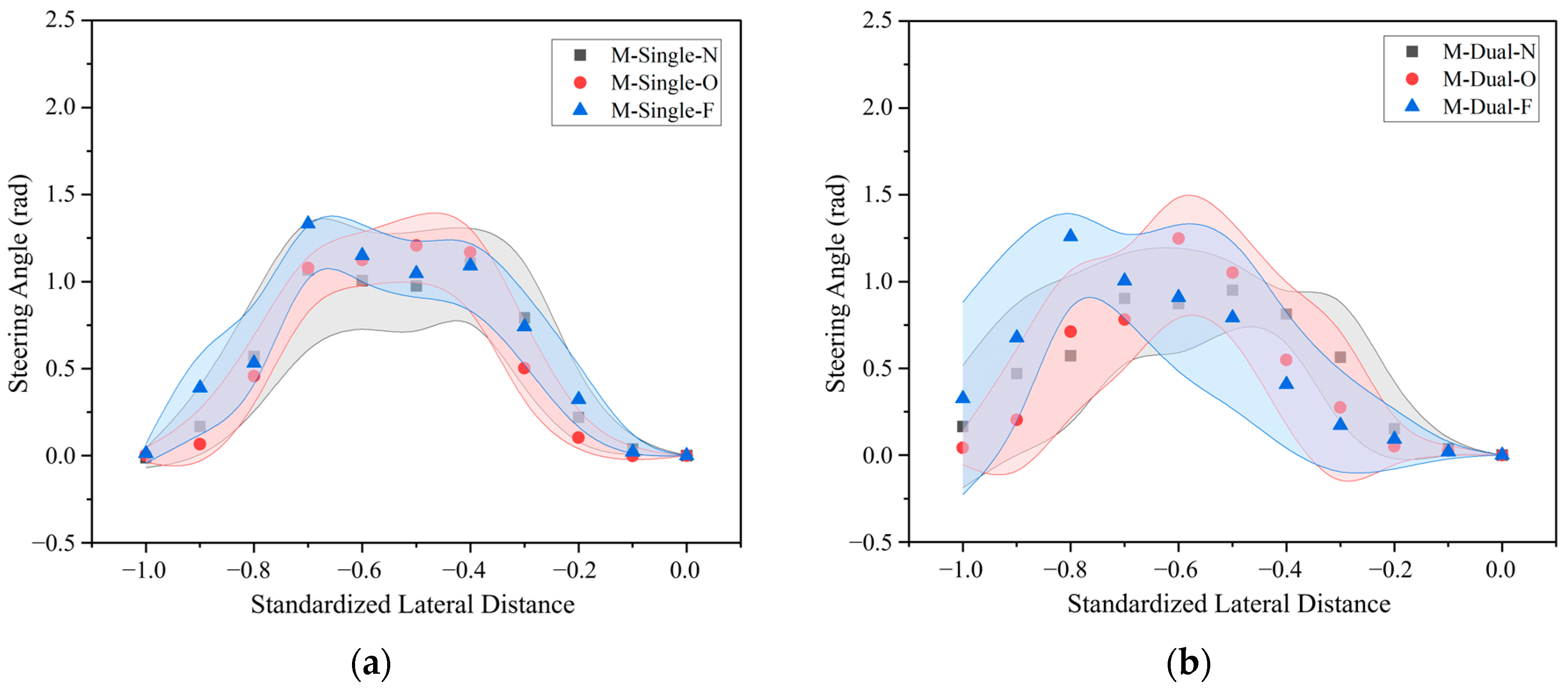
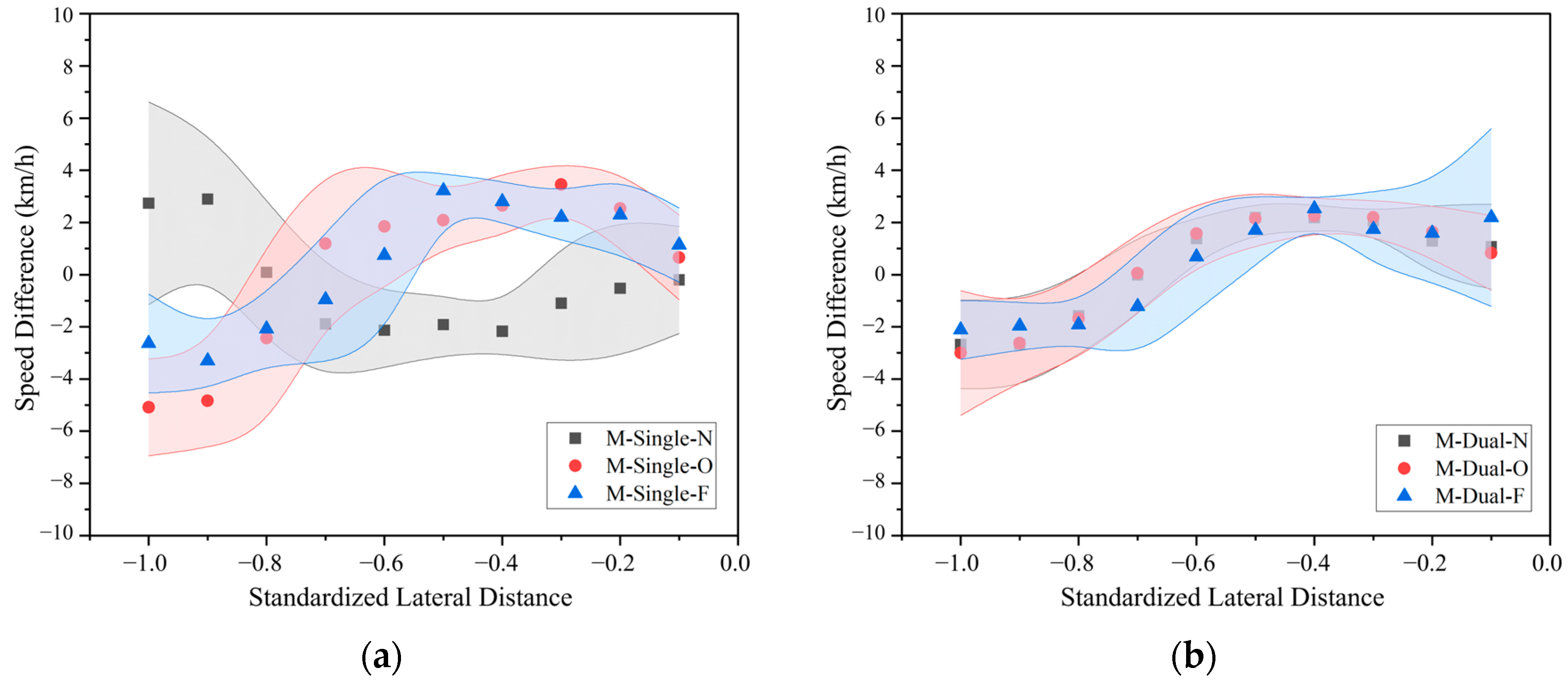


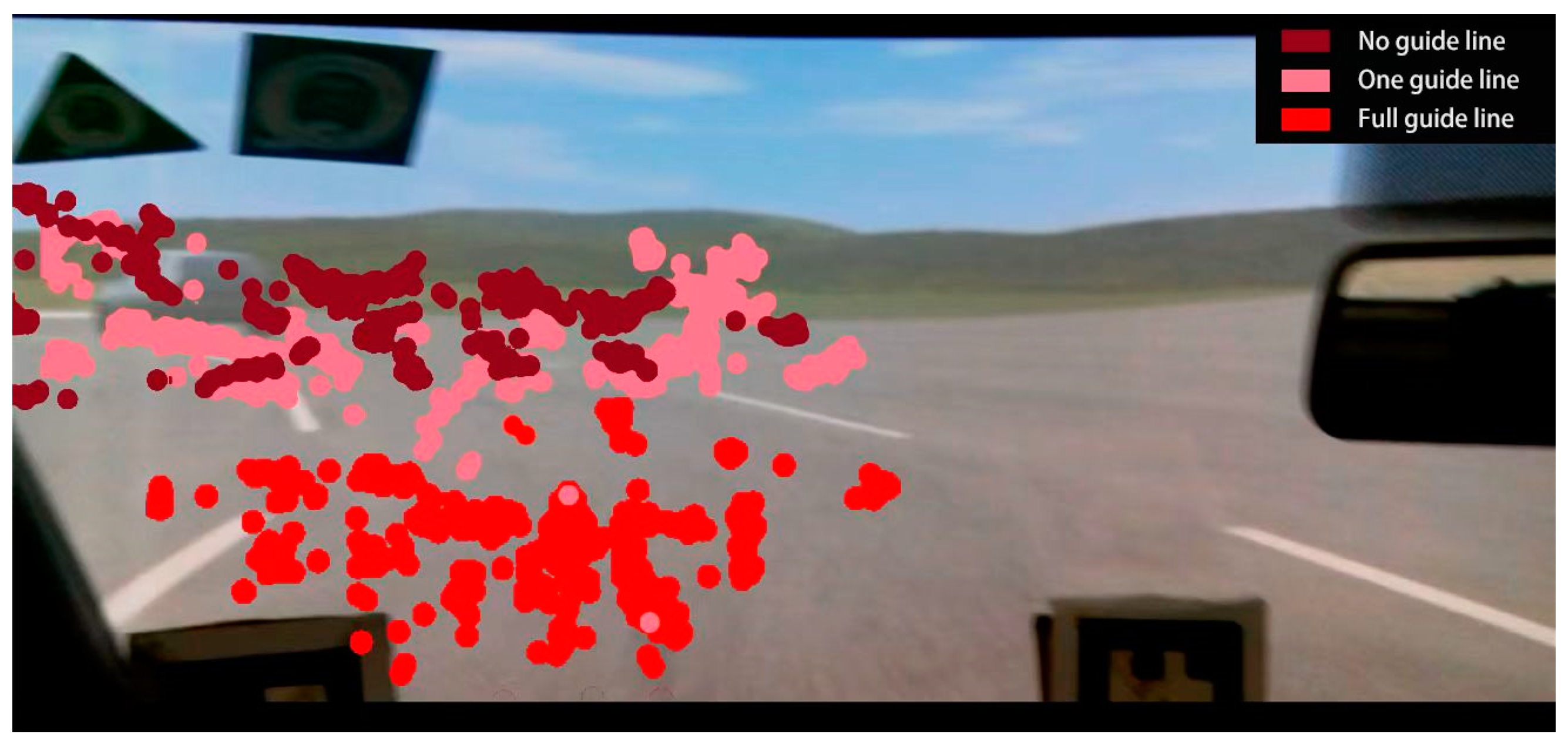

| Intersections | Size (m2) | Type | Entrance | Lanes Classification by Function | |||||
|---|---|---|---|---|---|---|---|---|---|
| Left-Turn Lane | Thru Lane | Thru Lane | Thru and Right Turn | Right-Turn Lane | Total | ||||
| HC Ring RD–SY RD | 3000 | Small | West | 1 | 1 | 2 | |||
| South | 1 | 3 | 4 | ||||||
| North | 1 | 2 | 1 | 4 | |||||
| HC Ring RD–YF RD | 2862 | Small | South | 3 | 1 | 4 | |||
| North | 2 | 3 | 5 | ||||||
| GB RD–HHW 3rd RD | 6512 | Medium | West | 1 | 1 | 1 | 3 | ||
| South | 1 | 2 | 1 | 4 | |||||
| North | 2 | 1 | 1 | 4 | |||||
| HC Ring RD–SG AVE | 14,994 | Large | East | 1 | 3 | 1 | 5 | ||
| West | 1 | 1 | 1 | 1 | 4 | ||||
| South | 2 | 3 | 1 | 6 | |||||
| North | 1 | 3 | 1 | 5 | |||||
| LG AVE–HC Ring RD | 8084 | Large | East | 2 | 3 | 5 | |||
| West | 1 | 2 | 1 | 4 | |||||
| South | 3 | 3 | 6 | ||||||
| Intersection | Small | Medium | Large | ||||
|---|---|---|---|---|---|---|---|
| Number of left-turn lanes | Single | Single | Dual | Single | Dual | Triple | |
| Major scenarios number | 1 | 2 | 3 | 4 | 5 | 6 | |
| Guide line setting | N: No guide line | 1-A: S-Single-N | 2-A: M-Single-N | 3-A: M-Dual-N | 4-A: L-Single-N | 5-A: L-Dual-N | 6-A: L-Triple-N |
| O: One guide line | 1-B: S-Single-O | 2-B: M-Single-O | 3-B: M-Dual-O | 4-B: L-Single-O | 5-B: L-Dual-O | 6-B: L-Triple-O | |
| F: Full guide lines | 1-C: S-Single-F | 2-C: M-Single-F | 3-C: M-Dual-F | 4-C: L-Single-F | 5-C: L-Dual-F | 6-C: L-Triple-F | |
| Scenario | S-Single-N | S- Single-O | M-Single-N | M-Single-O | L-Single-N | L-Single-O |
|---|---|---|---|---|---|---|
| S-Single-O | p = 0.6776 | |||||
| S-Single-F | p = 0.3258 | p = 0.5453 | ||||
| M-Single-O | p = 0.0284 | |||||
| M-Single-F | p = 0.1509 | p = 0.1124 | ||||
| L-Single-O | p = 0.9397 | |||||
| L-Single-F | p = 0.0082 | p = 0.0065 |
| Scenario | M-Dual-N | M-Dual-O | L-Dual-O | L-Dual-F |
|---|---|---|---|---|
| M-Dual-O | p = 0.8501 | |||
| M-Dual-F | p = 0.0082 | p = 0.0041 | ||
| L-Dual-O | p = 0.0005 | |||
| L-Dual-F | p = 0.0005 | p = 0.2899 |
| Scenarios | L-Triple-N | L-Triple-O |
|---|---|---|
| L-Triple-O | p = 0.0065 | |
| L-Triple-F | p = 0.0413 | p = 0.1510 |
| Scenarios | AOI 1 | AOI 2 | AOI 3 | AOI 4 | AOI 5 | |||||
|---|---|---|---|---|---|---|---|---|---|---|
| T (ms) | P (%) | T (ms) | P (%) | T (ms) | P (%) | T (ms) | P (%) | T (ms) | P (%) | |
| 1-A | 1585.95 | 26.27 | 0.00 | 0.00 | 510.57 | 8.46 | 1776.51 | 29.44 | 2162.97 | 35.83 |
| 1-B | 786.09 | 11.00 | 92.44 | 1.29 | 2449.67 | 34.27 | 3226.39 | 45.13 | 594.41 | 8.31 |
| 1-C | 823.48 | 12.06 | 49.95 | 0.73 | 4936.74 | 72.28 | 574.17 | 8.41 | 445.66 | 6.53 |
| 2-A | 1931.73 | 27.49 | 383.24 | 5.45 | 810.52 | 11.54 | 1711.41 | 24.36 | 2189.10 | 31.16 |
| 2-B | 740.51 | 8.49 | 0.00 | 0.00 | 2034.41 | 23.33 | 5136.83 | 58.91 | 808.25 | 9.27 |
| 2-C | 739.48 | 10.53 | 0.00 | 0.00 | 4892.81 | 69.67 | 1157.48 | 16.48 | 233.23 | 3.32 |
| 3-A | 1468.11 | 32.08 | 459.93 | 10.05 | 515.71 | 11.27 | 1264.18 | 27.62 | 869.07 | 18.99 |
| 3-B | 29.64 | 0.57 | 134.56 | 2.60 | 1448.97 | 28.02 | 3336.09 | 64.50 | 222.75 | 4.31 |
| 3-C | 88.52 | 1.71 | 70.64 | 1.37 | 4583.97 | 88.60 | 283.17 | 5.47 | 147.71 | 2.85 |
| 4-A | 3572.65 | 42.08 | 728.53 | 8.58 | 942.60 | 11.10 | 1109.28 | 13.06 | 2137.93 | 25.18 |
| 4-B | 377.50 | 5.39 | 190.09 | 2.72 | 1610.65 | 23.01 | 4574.30 | 65.36 | 246.46 | 3.52 |
| 4-C | 306.31 | 3.36 | 45.58 | 0.50 | 8228.72 | 90.38 | 372.03 | 4.09 | 152.36 | 1.67 |
| 5-A | 3212.45 | 53.78 | 325.93 | 5.46 | 540.03 | 9.04 | 1043.39 | 17.47 | 851.20 | 14.25 |
| 5-B | 223.42 | 4.81 | 36.20 | 0.78 | 966.65 | 20.81 | 3367.58 | 72.48 | 52.15 | 1.12 |
| 5-C | 203.55 | 3.25 | 0.00 | 0.00 | 5731.42 | 91.53 | 288.28 | 4.60 | 38.76 | 0.62 |
| 6-A | 2595.00 | 52.71 | 466.16 | 9.47 | 535.87 | 10.89 | 818.61 | 16.63 | 507.36 | 10.31 |
| 6-B | 1782.31 | 29.76 | 215.72 | 3.60 | 699.98 | 11.69 | 3290.99 | 54.95 | 0.00 | 0.00 |
| 6-C | 161.59 | 3.02 | 0.00 | 0.00 | 5002.58 | 93.65 | 162.21 | 3.04 | 15.62 | 0.29 |
Disclaimer/Publisher’s Note: The statements, opinions and data contained in all publications are solely those of the individual author(s) and contributor(s) and not of MDPI and/or the editor(s). MDPI and/or the editor(s) disclaim responsibility for any injury to people or property resulting from any ideas, methods, instructions or products referred to in the content. |
© 2024 by the authors. Licensee MDPI, Basel, Switzerland. This article is an open access article distributed under the terms and conditions of the Creative Commons Attribution (CC BY) license (https://creativecommons.org/licenses/by/4.0/).
Share and Cite
Yu, Q.; Ye, J.; Lin, W.; Dong, Y. Impact of Intersection Left Turn Guide Lines Configuration on Novice Drivers’ Behavior. Appl. Sci. 2024, 14, 7387. https://doi.org/10.3390/app14167387
Yu Q, Ye J, Lin W, Dong Y. Impact of Intersection Left Turn Guide Lines Configuration on Novice Drivers’ Behavior. Applied Sciences. 2024; 14(16):7387. https://doi.org/10.3390/app14167387
Chicago/Turabian StyleYu, Qifeng, Junjie Ye, Wuguang Lin, and Yu Dong. 2024. "Impact of Intersection Left Turn Guide Lines Configuration on Novice Drivers’ Behavior" Applied Sciences 14, no. 16: 7387. https://doi.org/10.3390/app14167387
APA StyleYu, Q., Ye, J., Lin, W., & Dong, Y. (2024). Impact of Intersection Left Turn Guide Lines Configuration on Novice Drivers’ Behavior. Applied Sciences, 14(16), 7387. https://doi.org/10.3390/app14167387






